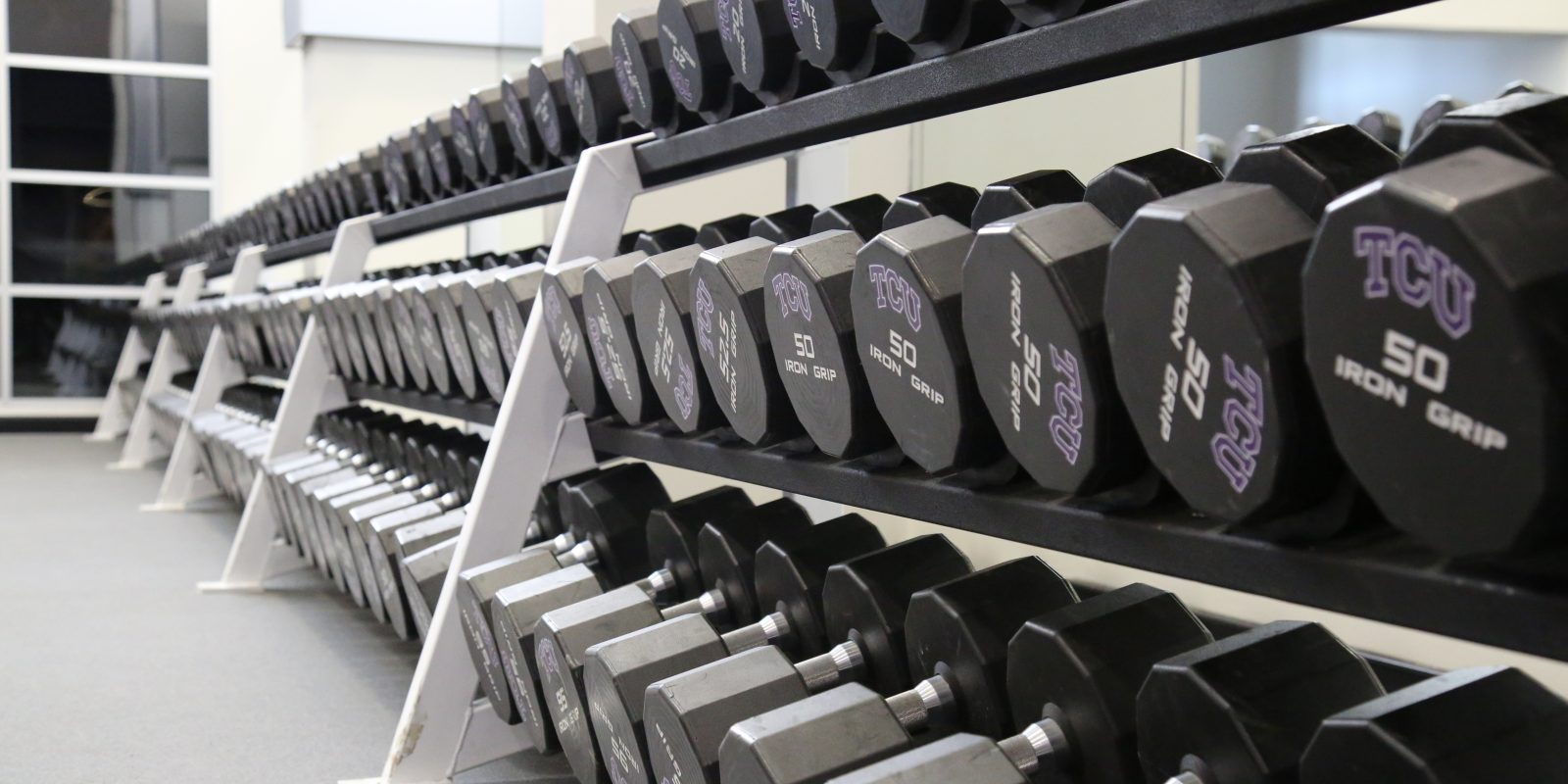
Courtesy of TCU Athletics
Michael Wood Focuses on the Foundations of Optimal Movement
The strength and conditioning senior assistant coach talks about how movement is medicine and breaks down misconceptions about the weight room.
Michael Wood ’17 MS, the senior assistant strength and conditioning coach for nearly 100 student-athletes, works to build solid foundations for optimal performance.
Some people think of weight rooms as just places to pump iron. Are there any stereotypes you’re trying to combat?
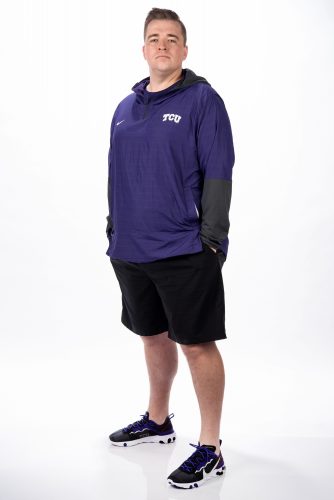
As senior assistant strength and conditioning coach for TCU Athletics, Michael Wood trains volleyball, men’s and women’s golf, and men’s and women’s swimming and diving student-athletes. Photo by Glen E. Ellman
Ever since I’ve been in the industry, we’ve been going through a little bit of a transition. It has gone from how much can you make an athlete lift — like one-rep max sort of stuff — to focusing on the quality of the movement. How is what we’re doing going to positively impact the athlete, rather than just putting a ton of load on a person, which might help them or it might break them. We also have a bit of a stigma that we’re punishment coaches who run really difficult practices and training sessions that just make our athletes vomit, and that’s kind of the marker of a successful strength coach. I think that stigma is leaving us as well now, which is good.
There is a ton of science and practical anecdotal information that we apply to our training programs and how we coach.
What is the role of strength and conditioning in TCU Athletics?
We’re always trying to broaden what strength and conditioning is. I don’t think of it as just the weight room. I think that the weight room is a great tool to facilitate increased performance, but I don’t think it’s the be-all and end-all. For example, as a department, we do a lot of different things on the court, on the field, in the pool. We do a lot of different things that aren’t necessarily about throwing around weight that are going to increase performance.
In the past, I’ve done a lot of warmups for my teams. The first 15 to 20 minutes of everyday practice, we’ll do a full-blown warmup. And the strength and conditioning coaches are in control of that. We do a lot with regards to speed training, if we’re trying to increase velocity. Obviously that doesn’t really make sense to happen in the weight room, so we’re really lucky that we’ve got this massive, full-size indoor football field right here. We do a lot of our work there. We’ll also go to our team’s facilities and do workouts to facilitate performance.
It all boils down to a few principles I have. Strength and conditioning, to me, is a lot more than sets and reps. I believe that we’re kind of like a bicycle wheel. Strength and conditioning is just one spoke of that bicycle wheel. There are also athletic trainers, physical therapists, mental health specialists, academics, technical and tactical select sport coaches, nutrition. When those teams are communicating well, they’re transparent and they all pull in the same direction, and some really cool things can happen. Strength and conditioning doesn’t happen in a vacuum.
What was your soccer career like?
I got to play with a couple professional soccer teams in England. I came to America to play soccer in 2007. I started my collegiate soccer career at Long Island University in Brooklyn, New York, then transferred to Midwestern State in Wichita Falls, Texas. I went from living in Brooklyn to living in Wichita Falls. And it was great. I loved my times at both of those places.
I ended up getting my undergrad degree from Midwestern State. Then I was a graduate assistant in the weight room at Midwestern.
Strength and conditioning is an interesting field; you have to have an internship. The higher the profile of the internship probably helps you out a little bit more. TCU is the closest Division I school to Midwestern State, so I ended up mentoring under Zach Dechant. He does a really, really fantastic job with the internship program here. He places probably 10 to 20 interns who have come into the program and then go on to either be graduate assistants and get a degree or go into the field and be fulltime strength coaches every year. Zach’s great. He’s one of my best friends. The work he does with the interns to prepare them is probably the best in the country.
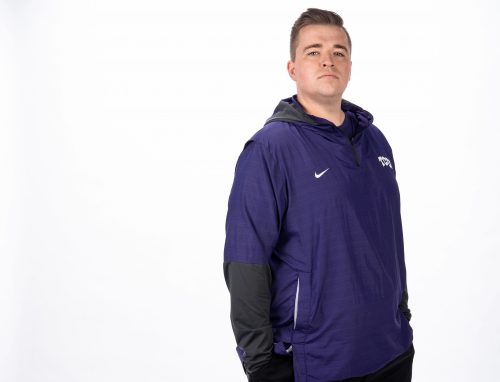
Michael Wood focuses on nurturing lifelong athletes and works to keep student-athletes moving optimally for their sport. Photo by Glen E. Ellman
How are strength and conditioning different?
We can’t really think about it like that. We want to have as much capacity to perform high-intensity, high-quality, game-specific movements as frequently and as with little recovery time as possible. If your job is to jump your max effort, or as close to max effort as possible, as frequently as possible, the conditioning piece is going to facilitate that and give you the ability to do that.
One way we talk about strength and conditioning is as an engine and a gas tank. If you think about the engine being like strength and power, the gas tank is the ability to produce and endure over a long period of time. A lot of the time we are stress managers. I have to have my finger on the pulse of where the teams are in the season and what’s going on in the classroom. Research suggests that injury risk is highest during periods of heightened academic stress, rather than periods of heightened physical stress, so like preseason versus a finals period. There was research that came out a few years ago in football that suggested that during finals period there was a heightened risk of injury versus in the preseason period, which got me really interested in thinking about the intensity and the volume of practice and how much you’re actually doing in those two periods. But stress is stress. If I’m trying to push them and get 100 percent max effort in the weight room, but then also trying to push and get 100 percent max effort with the conditioning piece, something’s probably going to break. I have to make sure that the conditioning is complementing the strength and power work that we’re doing and vice versa, and also complementing what the athletes and coaches are trying to achieve in practice.
“I have to have my finger on the pulse of where the teams are in the season and what’s going on in the classroom.”
Michael Wood
Your athletes are also students, so their time and attention levels are different from a professional athlete’s. How do you work with students to balance those pieces?
Communication. I’m lucky that I have a really good relationship with the coaches I work with. That takes effort and time on both parts. But also, the sports medicine staff are fantastic here. We go out of our way to make sure we’re on the same page when we communicate. There are a lot of variables that we have to try and control as best as possible, and we understand that we can’t. There’s also the added layer of having student-athletes who are trying to compete and get to the Olympics. We have a number of swimmers who have an opportunity next summer to make the Olympics, which is fantastic. But it’s another piece to the puzzle, and it’s another thing that we have to try to get our heads around.
We go as far as looking at what classes an athlete has. I think at some point, we have to kind of put that in the back of our heads. Sometimes they have class on a game day, sometimes they don’t have class on a game day. We just have to get on with them. We’ve got to perform.
The strength and conditioning coaches use quite a bit of technology. What devices do you use, and what do they tell you?
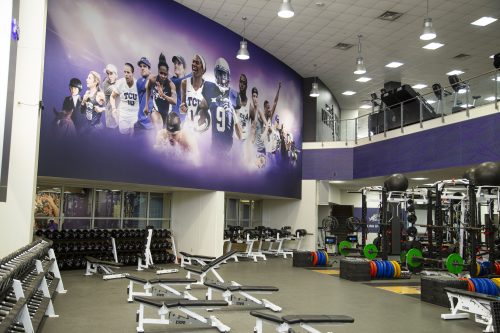
The Bob Lilly Performance Center provides 18,000 square feet of workout space for TCU Athletics. Courtesy of TCU Athletics
One of the things that I’m big on is using as much objective information as possible. We’re really lucky that we invest in technology at TCU. We have these things called force plates — basically two panels the size of a book or an iPad — that you stand on. You can do a series of different jumps. The force plate is going to measure how ready you are to train by measuring your central nervous system readiness. We use that in conjunction with heart rate monitors that almost all of my athletes wear. Those allow me to assess what’s happening internally, to see the stress response from a practice, to make sure that we are training in the right energy zones to try and prepare for games.
We’ve used a series of tests in the past that analyze heart rate variability, which was used by the Soviets back when the space race was going on. We measure the difference in time between two beats of the heart. It gives us information to see how ready you are to train and see what you’re prepared for.
Soccer, for example, uses a GPS system. All the soccer athletes wear like a sports bra with a pocket in the back that holds a sensor that’s connected with satellites. Those devices give you a ton of different metrics that you can spend hours diving into, looking at what sort of speeds, distances, changes in direction, jumps that the athletes went through in the practices, preparing them for a game. There are a ton of different aspects to what we do as strength and conditioning coaches.
Student-athletes at TCU come in with different levels of experience with strength and conditioning, depending on what their previous school had. How do you get their buy-in for all the technology and strategy?
I was a student-athlete; I played at a pretty good level in my life. The reason I became a strength coach is because I never had a strength and conditioning coach to tell me what’s good and bad — I just kind of trial-and-errored it. I did more bad than I did good. I hope that I give my student-athletes what I didn’t have.
“Everything I put into my program has a purpose.”
Michael Wood
I like to think I have a really good relationship with my athletes because I invest time, and I’m fascinated with leadership structure — I’m constantly reading and trying to find different ways that I can connect with my athletes to try and increase buy-in. This will ultimately help me out, and it’s going to help the team and the student-athlete as well.
I anticipate that when student-athletes come in the door, they probably have zero trust for me. I’m a new guy. I don’t play many of the sports I cover. I have to make sure that I’m building relationships with my student-athletes. I also have to try my best to show that what we’re going to do from a strength and conditioning standpoint is going to help them out as an athlete. I’m really big on telling my student-athletes why we’re doing something so they have that understanding by the time we get to more individualized programming.
It gets really challenging when an athlete comes in and they’ve been really successful as a youth athlete, but they’ve been doing it in suboptimal ways. I have to find a more optimal way for them to get the same, if not better, results with lower output, less cost, more economy. It will take time because the relationship needs to be there.
I’ve done this for years. I’ve had success with this. I want to continue to do it. I want to find that better way.
How do you customize a workout to be position-specific?
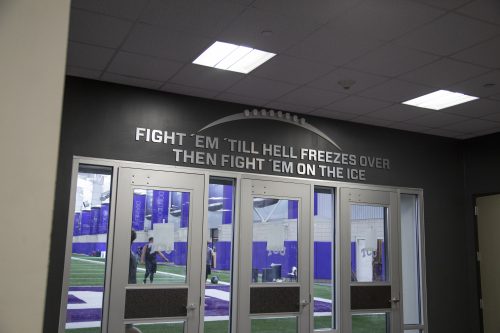
Student-athletes frequently use the Sam Baugh Indoor Practice Facility and Cox Field. Courtesy of TCU Athletics
The first piece is communicating with the athletic trainer, sports medicine, getting a good medical history on the athlete, making sure that nothing we do in the weight room is going to cause harm. That’s number one. It ties back into the principle of making sure athletes are available for practice and competition.
If there are no problems, then we will go through an assessment. We use a couple of different tools to assess our athletes here. We look at how they move in some very basic movement patterns, kind of grading that to see what is good and what needs improvement. What we look for in that screening process is how the athlete moves left to right, if there are any asymmetries, if there are any imbalances. We’ll try to identify and correct those as soon as possible so we can build a program around that. We use force plates to measure how we produce force, how quickly we produce force, how the athlete reacts with the ground. Then we do a couple of different jump tests to see if there’s any room for improvement with an athlete’s ability to jump. From there, we do a needs analysis. This is basically us going through the sport and breaking the sport down into its most fundamental parts: What does the sport entail? Is it a collision sport like football? Is it a sport where sprint speed is going to win you the game, more like soccer? Is it a jump, land, change direction, deceleration sport more like volleyball? Is it a sport like golf where it’s about how can you react with the floor and swinging the club as fast as you can?
Female athletes are more predisposed to ACL and knee injuries because of the way the hips are set. We have to make sure that we’re targeting glutes, hamstrings, jumps, landings, good patternings to try to decrease those odds of injury. We look at positional differences: We’re going to train a goalkeeper differently than we would train a center midfielder in soccer. We then put that all together into a program that has the end goal in sight, but we work backwards from that by watching game film, looking at metrics from competition like heart rate data, GPS data, things that we can benchmark and understand.
“Nothing that we do is going to be perfect. But we can always try and be more optimal.”
Michael Wood
How did returning from the Covid-19 gap change your perspective for training?
I assume that some athletes did a lot over the quarantine period, but I have to assume when we’re returning to training that my athletes did nothing. Otherwise catastrophic things could go wrong. We started off slow over the first couple weeks. We’re working on patterning and positions. As we progress, we will add more volume, more intensity and more complex movement patterns.
We had to shift our mindset. We went from training for performance to training for staying healthy.
Were you able to communicate with student-athletes during the coronavirus shelter-in-place orders? What were they doing during that time?
The NCAA mandated that we weren’t allowed to make any physical activity mandatory and we weren’t allowed to monitor any physical activity.
I encouraged all of my athletes to stay active. During quarantine, people who switched to working from home decreased their daily output so much compared to when they were going to the office. You’re cutting down a few thousand steps a day.
We encouraged student-athletes to get outside and go for a walk, get some vitamin D, find an audiobook or podcast, get that sweat on every couple of days.
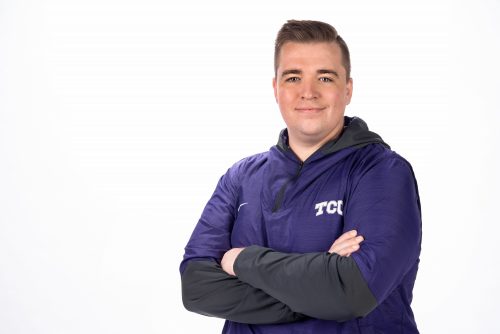
Michael Wood said he wants to develop confident lifelong athletes who remember the skills they gained at TCU. Photo by Glen E. Ellman
Athletics supported us in putting out some care packages. We tried to fill some gaps that a home workout has. It’s difficult to get the pull-in motion at home. Unless you have a pull-up bar or a band, you don’t really have a way to go against gravity for posterior back-movement patterning. You also miss out on the ability to externally load. We sent out some different bands, a jump rope and a strap that could be anchored to a doorframe instead of barbells and dumbbells. If an athlete wanted to work out, they had tools. One of my worries was that an athlete would want to work out or train but didn’t know what to do. We made sure they had the information and the means to train.
I wasn’t allowed to communicate with student-athletes about training because it was a liability. If one of my athletes posted a photo of them working out on social media, I wasn’t allowed to like it or endorse it. It was challenging for me because those interactions are why I do my job.
For the hand we were dealt, I feel like we handled it well. We were there for our athletes and that’s what’s important.
Does everyone have to wear a mask in the weight room?
Yes. They’ve actually been really well — they’ve not really had a problem with it or put up much of a fight with it. I think they all understand how important it is that we get to play. They’ve been pretty mature about it. We haven’t had any issues, which makes my job easier.
We also have to keep ourselves safe. So, yeah, we’re taking it really seriously. We’ve got a good system set up and it’s gone well so far. We’ve made it as seamless and as normal as possible.
Part of TCU Strength & Conditioning’s mission is to train both the body and mind for a lifetime of fitness. In what aspects are you and your team training minds?
There’s a connotation that gyms are difficult places to be. I want my student-athletes to be able to leave TCU, go into a 24 Hour Fitness or an LA Fitness, load up a bar in the squat rack and feel comfortable doing so. I want them to understand how to put together a good training program, how to have a good cycle of exercises. I want to give them the education to have full autonomy over their own programming. I don’t want them to leave a weight room that is very businesslike and then go to a gym and feel uncomfortable. I want them to have the knowledge and the education so that they can train themselves. If they’re going to turn professional, they’re going to have to do that. But for the 90 percent of my athletes who don’t turn professional, it’s important to develop some understanding and knowledge about training — what feels good for your body and what doesn’t, the right ways to move and the less-optimal ways to move — to then be 35, 40, 50 years old and still be able to put those principles in place. That’s the why behind a lot of what we do.
“We are all athletes no matter what we’re doing.”
Michael Wood
We are all athletes no matter what we’re doing. Being able to move correctly is the difference between living well in our olden years versus not. Movement, as cheesy as it sounds, is medicine. The better you move and the more efficient you are, the better you’re going to feel.
Mental health is becoming more of a focus and we’re starting to learn more about it. Psychology of exercise and fitness is huge. I don’t want athletes to be intimidated walking into a gym. I want them to go in there and say, Yeah, I’m going to squat more than you right now, and take that competitive streak we all have into training.
What’s the most difficult or unique routine you’ve created?
I’m only going to put my athletes through a training program I know they are going to succeed with. We do push a little bit.
I think there is a bit of a misconception with mental toughness — the idea of breaking an athlete down to the point of no return and then all of the sudden they bounce back and they’re mentally tough. I wrote my thesis at TCU about mental toughness in soccer when I was working with the soccer team. Research suggests mental toughness — and the perception of mental toughness — depend on your perception of how prepared you are for training. I try to bolster that perception by making the athlete feel like they are more prepared, which then indirectly suggests an increase in mental toughness.
In addition to the weight room, you and the strength and conditioning team work where athletes practice. Where is the point at which your supervision ends and the head coach’s begins?
If what I’m doing in the weight room isn’t complementing what they’re doing on the field or court, it’s suboptimal. We could be doing something else. The head coach has a lot of say in what happens on the court. I’m lucky that I work with some really forward-thinking head coaches who listen to my input. We’ve built our relationships in the same way I have with my athletes. They listen to what I have to say. One of my favorite quotes, and I have it on my office wall, is, “Without data, you’re just another person with an opinion.”
“If what I’m doing in the weight room isn’t complementing what they’re doing on the field or court, it’s suboptimal.”
Michael Wood
We’re lucky we use technology to drive and aid the decision-making process and create conversation. I’m never going to tell a coach what they are doing is wrong, but I talk to them the same way I might have a conversation with a student-athlete: maybe there is a better way we can do things; maybe there is a better way we can structure practice. I can foster that difficult conversation about optimizing things and use the data to drive that. Then it’s not biased; it’s pretty black and white. I know when to stay in my lane and offer advice. If a coach comes to me about a student-athlete needing more help with the internal rotation of the hips, then we can incorporate more of that in training.
At the end of the day we’re not working with professional athletes. We’re working with amateur athletes who are elite in their sport and they’re trying to get a degree as well. If we aren’t all on the same page and we aren’t trying to roll in the same direction, at the end of the day it’s the student-athlete who gets let down. These athletes aren’t earning millions of dollars. We have to make sure what we’re doing is as transparent as possible, there is a why and we’re doing the best for our athlete.
Editor’s Note: The questions and answers have been edited for clarity and length.

Your comments are welcome
1 Comment
That was an excellent article explaining the modern
day strength and conditioning coach function. I thought the explanation on how the training can transition to post collegiate life in having the confidence and knowledge to create a work out program for yourself.
Michael Wood , combines so many factors into his training, he is very comprehensive and dedicated.
Related reading:
Features
Training and Technique Help Improve Performance and Stave off Injury
Professionals in dance, music and sports rely on the health and agility of their bodies to maintain long careers.
Sports: Riff Ram
Brooke Helms Manages Nutrition Needs of Athletes
The director of sports nutrition designs meal plans and provides one-on-one counseling sessions with student-athletes.
Alumni, Sports: Riff Ram
Zarnell Fitch is a Rock Star Football Recruiter
The defensive line coach talks about recruiting and his admiration for Coach Gary Patterson.